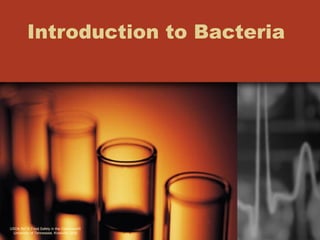Weitere ähnliche Inhalte Ähnlich wie Introduction to bacteria_02 (2) (20) 2. What are bacteria?
• Single celled organisms
E. Coli O157:H7
• Very small can make you
very sick.
• Need a microscope to see
• Can be found on most
materials and surfaces
Streptococcus
– Billions on and in your can cause strep
throat.
body right now
This E. coli helps
USDA NIFSI Food Safety in the Classroom©
University of Tennessee, Knoxville 2006 you digest food.
3. What do they look like?
• Three basic shapes Bacilli
– Rod shaped called bacilli
(buh-sill-eye)
– Round shaped called
cocci (cox-eye) Cocci
– Spiral shaped
• Some exist as single
cells, others
cluster together
USDA NIFSI Food Safety in the Classroom© Cluster of cocci Spiral
University of Tennessee, Knoxville 2006
4. Bacteria are ALIVE!
• What does it mean
to be alive?
– They reproduce
(make more of
themselves)
– They need to eat
USDA NIFSI Food Safety in the Classroom©
University of Tennessee, Knoxville 2006
5. How do bacteria
reproduce?
• Grow in number not in size
– Humans grow in size from child to adult
• Make copies of themselves by
dividing in half
– Human parents create a child
USDA NIFSI Food Safety in the Classroom©
University of Tennessee, Knoxville 2006
6. How do bacteria eat?
• Some make their own food from
sunlight—like plants Photosynthetic
bacteria
• Some are scavengers
– Share the environment around them
• Example: The bacteria in your stomach
are now eating what you ate for breakfast
Harmless bacteria
• Some are warriors (pathogens) on the stomach
lining
– They attack other living things
• Example: The bacteria on your face can
attack skin causing infection and acne
E. Coli O157:H7
USDA NIFSI Food Safety in the Classroom©
University of Tennessee, Knoxville 2006 is a pathogen
7. What is a pathogen?
• Bacteria that make you sick
– Why do they make you sick?
• To get food they need to survive and
reproduce
– How do they make you sick?
• They produce poisons (toxins) that result in
fever, headache, vomiting, and diarrhea
and destroy body tissue
USDA NIFSI Food Safety in the Classroom©
University of Tennessee, Knoxville 2006
8. Where do you get a
pathogen?
Indirect contact
• Contact with people who are sick
– Direct or indirect
• Food, Water, or other Surfaces that
are contaminated
Foods that
could be
contaminated
USDA NIFSI Food Safety in the Classroom©
University of Tennessee, Knoxville 2006 Direct contact
9. A Closer Look – Where do
you get a pathogen
Direct
Contact
Indirect
Contact
Foods and water
may be
contaminated
USDA NIFSI Food Safety in the Classroom©
University of Tennessee, Knoxville 2006
10. Are all bacteria pathogens?
• No, most are harmless
• Some are even helpful
– Examples of helpful bacteria:
• Lactobacillus: makes cheese, yogurt, &
buttermilk and produces vitamins in your
intestine
• Leuconostoc: makes pickles &
sauerkraut
• Pediococcus: makes pepperoni, salami,
& summer sausage
USDA NIFSI Food Safety in the Classroom©
University of Tennessee, Knoxville 2006
11. A Closer Look – Helpful
Bacteria www.bioweb.usu.edu
Pediococcus - used in
production of fermented meats
Lactobacillus casei – found in
human intestines and mouth to improve
digestion
Leuconostoc cremoris –
used in the production of buttermilk and
USDA NIFSI Food Safety in the Classroom© sour cream Lactobacillus bulgaricus –
University of Tennessee, Knoxville 2006
used in the production of yogurt
12. What are some common
pathogens? E. coli
O157:H7
• Pathogenic E. coli
(like O157:H7)
– Found in ground beef, contaminated
fruits and vegetables
Salmonella
• Salmonella
– Found in raw meats, poultry, eggs,
sprouts, fruit and vegetables
• Listeria
– Found in deli foods, lunch meats,
smoked fish and vegetables
USDA NIFSI Food Safety in the Classroom©
University of Tennessee, Knoxville 2006
Listeria
13. Examples of Pathogens
Salmonella
E. coli O157:H7
What shape are
Staphylococcus these bacteria?
aureus Cocci, bacilli, or
spiral?
Campylobacter
jejuni
USDA NIFSI Food Safety in the Classroom©
University of Tennessee, Knoxville 2006
14. How can I avoid pathogens?
• Wash your hands often so you won’t
transfer bacteria to your mouth or
food
– Warm water with soap for 20 seconds,
rub hard between fingers and nails
USDA NIFSI Food Safety in the Classroom©
University of Tennessee, Knoxville 2006
15. How can I avoid pathogens?
• Cook food thoroughly to kill
any pathogens that may be
in your food
• Store food properly to limit
pathogen growth
– Cold temperatures (40°F)
USDA NIFSI Food Safety in the Classroom©
University of Tennessee, Knoxville 2006
16. Review
• Bacteria are living organisms
• Most are harmless
• A few are pathogens that make
you sick
• You can reduce the risk of
getting sick by washing your
hands and handling food
properly.
USDA NIFSI Food Safety in the Classroom©
University of Tennessee, Knoxville 2006

